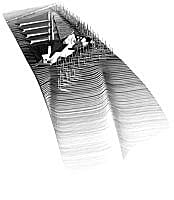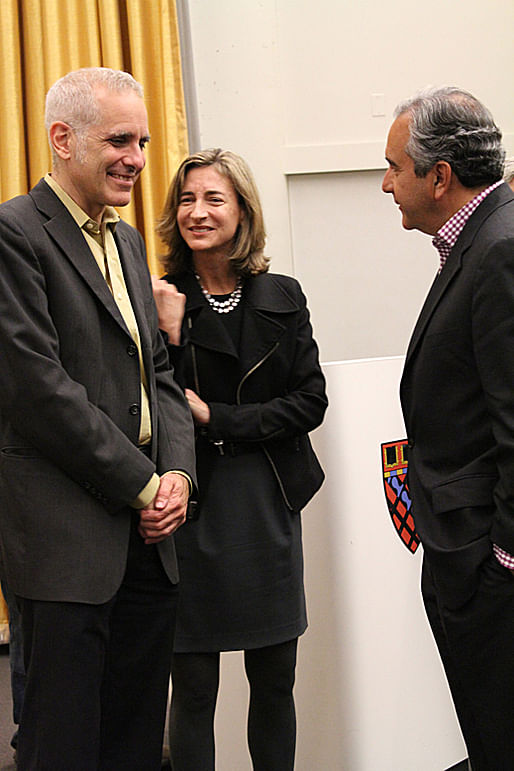
Hello Archinect!
My current studio critics, Marion Weiss and Michael Manfredi, are lecturing in front of the gold curtain tonight. You can also watch the whole thing on the GSD's YouTube channel.

6:36: Scott Cohen is making introductions. Lots of awards, great projects, Ivy League educations and teaching posts.
And then: "They are not only committed to a new model of practice or a new unity of mediums, but wish to activate these from a decidedly architectural perspective--meaning by means of the tectonic, the magnificent play or behavior of light and materials molded to architectural shapes and elements--lines, planes, and volumes--composed according to the spatial tropes of interior vs. exterior, the sequences and hierarchies entailed in all these spaces with the aim of shaping specific social configurations."
"But...the key underlying sensibility in their work is that...it conflates the perception of aesthetic forms with large-scale infrastructural constructs. ...This relationship is not the...pre-processed or standardized, but that which is not yet brought to a level of maturity. I mean this in the best possible sense: their work is early, not late."
"Imagine a time in America [when architectural ideas were new]...Well, we have that time again."
6:43: Michael Manfredi: "For us, the territory of architecture should concern itself with the whole of the built environment...Today, all architects--and indeed, all designers--must work in a hybrid manner."
"Our projects...avoid neat definitions and plainly delineated edges...they operate at the peripheries of disciplines."
Marion Weiss: "As Scott suggested, we've been looking for the police force to release the shackles between architecture, landscape architecture, urban planning, engineering, and infrastructure; and the GSD is well-suited to do this work."
"Not just occupying a site, architecture has the potential to transform it."
6:50: The first project they're presenting is the 'Museum of the Earth' in Ithaca. The five finger cuts in the geography around Ithaca were formed by glaciers, and this process also created perpendicular cuts in the hill that informed their project.
6:52: Michael Manfredi: "These very simple sculptural forms (stone-covered berms) calibrate the geology. And the building becomes a kind of metering device."


6:56: Brooklyn Botanic Garden. "It's a Janus-like site, mediating between the city and garden. ...The building is something you slide through; it's never something you never stop at. It's meant to guide you to and through the garden." Its sinuous form is constructed of a series of moment frames.

It's a garden path, a "wandering curvature that opens out; one storey at one side and two stories at the other. The garden is very excited that the roof looks exactly like a Gingko leaf, but for us it's more about the fact that the path or garden is also a building."
7:00pm: Next project: some kind of top-secret "international retreat" for an undisclosed client. There is a conference room with acoustics and an audio system sufficient to amplify Kofi Annan's voice inside what used to be a horse-stable. And a more casual meeting place of the kind without which "real dialogue cannot happen."
7:04: "One of the hardest arguments you make as an architect is that 'no, you don't want an efficient building, because nobody will want to be in it. So this is a hallway that is not efficient, but that wanders" and allows for spaces for people to meet, to sit, etc.

7:09: Barnard College Diana Center: "Our question was: can we take the scale of this landscape move and bring it through the building? In a sense these were all intuitive ideas and sketches, but we pursued them with vigor."
"And this isn't Harvard, where you have wandering pathways (on the flat); things are compressed vertically, so we wanted to [express this path]."


7:14: The context is brick, and they wanted to relate to that context without literally using brick; hence the brick-colored glass. It's acid-etched and the colored back-pan allows light to pass through the glass and reflect only off the back--so the glass changes color throughout the day. "That allows us to use things like the stair as a figure against this neutral backdrop."

"We wanted to think about the building as asserting itself--having a certain autonomy--but also as having a series of landscape and urban relationships."
7:17: Taekwondo Park Master Plan: Building close to a million square feet on a giant valley site, with cultivated ginseng terraces.
This frenetic, neon-like image doesn't fully reflect the slides they're showing. But it gives you a sense of the site.
7:21: Ha! They have a series of bridges named for the different belt colors in Taekwondo.
We're looking at an outdoor playing field on the park, with a series of stepped terraces; Michael is saying that the terraces meter the landscape and allow you to read a scale into it.
Not unlike in the Brooklyn Botanical Garden, there's a part of the project that is more architectural, where the building asserts itself more, and a part that is more tranquil, where the landscape provide the main reading.
7:25: Don River Watershed in Toronto:

"We were fascinating by the use of hydrology" to shape the arcs and curves in the land. There are different zones that accommodate different levels of flooding, and one--a series of low-lying soccer playing fields--that becomes a "sacrificial zone" in the case of a 100 year storm.
"We look for ways to reframe the Piranesian artifacts [of massive highway overpasses, etc.]"
7:28pm: Olympic Sculpture Park: "The site that this museum acquired was shaped by man in ways that you can't imagine." The site is divided twice: once by a train-tracks and once by a highway. Instead of covering over the entire site and thereby losing its character, they decided to cross it "in an earthwork that restores the original topography that had been de-graded." In so doing, they re-built a beach that is now the only place you can access the water via a beach in Seattle.


The process was many years and involved many changes and negotiations.
To save money, instead of making all-concrete retaining walls, they used gabions under concrete panels, and all of this could shift in the case of an earthquake.

[Richard Serra during installation of his sculpture.]
For Richard Serra's piece which occupies an entire valley, they had to build the foundations for each piece of steel fifteen feet wider in each dimension "in case hey changed his mind about the final location of any piece."

One of the sculpture pieces is an enormous log typical of the Pacific Northwest, covered over with various plants and insects, under a green-tinted window that makes the light similar to in a west-coast rainforest. Michael describes this as an "inversion of nature and culture."
"And we love the play of these slightly lurid colors and the crispness of the birch grove."
There's also a series of underwater terraces for salmon habitat. "This being Seattle, we had not one salmon expert, but two, and they disagreed. So there was a lot of discussion about the architecture of juvenile salmon habitat. But on a more serious note, the project is about [bringing the city to nature and the nature to the city.]"
7:42: St. Louis: They were looking at two sides of the St. Louis Waterfront, and thinking about the flows of water, people, and cars. "It wasn't one site, but many sites...kept apart from each other. ...But if we restore the river at its center, then the whole project becomes different."

They shaped the waterfront so that at low water levels, you have a continuous approach to the water; and at high water levels, you have two bluffs, or little islands, that provide waterfront access and that in turn are accessed by footbridges.

Now they're showing an animation of the St. Louis project that focuses on movement through the site and the changes it undergoes throughout the year. ...Oh, I hope they don't make us do animations this semester...that's too much work for me.

7:51: Done. Questions?
Student question: "In the earlier projects, there was a tendency to show movement in a linear way, as in a linear narrative;" and in the later ones, the sites are so large and complex that there may not be a linear narrative of this type. How do they think about this? Answer: Great question in the context of a book they're working on called "Sequence and Section." For them, it's often both.
Student question about whether they design parametrically or whether they "just feel a curve" and go with it. Marion answers by telling a story about when she was a young student of James Stirling:
[In a nervous young voice]: "So I asked him 'So how do you do this? And how do you convince people to do this?' And he answered [now in a funny old man's voice] "Well, I only talk about technical things. I never talk about design because everyone has their own opinion about design."
Student question about influences: some of their work looks like [a Peter Zumthor project; didn't catch which]. Answer: "Well, we know Peter Zumthor's work." [Laughter] "And sometimes it registers subliminally; so thank you for the compliment."
Follow-up question: their process was presented in a really teleological, continuous way; is it really like that? Answer: not at all; it's a complex mess and then when they have to re-conceptualize and present their work, they dig through their artifacts to find a way to tell the story.
Thanks for reading!
Lian
[Some images were from the lecture, but most were from the Weiss/Manfredi website.]

[The ghosts of architecture critics past and present: Scott Cohen, our first semester studio coordinator; Marion Weiss, one of my current critics; and Jonathan Levi, my third semester critic.]
This blog was most active from 2009-2013. Writing about my experiences and life at Harvard GSD started out as a way for me to process my experiences as an M.Arch.I student, and evolved into a record of the intellectual and cultural life of the Cambridge architecture (and to a lesser extent, design/technology) community, through live-blogs. These days, I work as a data storyteller (and blogger at Littldata.com) in San Francisco, and still post here once in a while.



10 Comments
Sitting idly, popcorn popping.
Haha, thanks Paul!
Nice job Lian! Next best thing to being there in person.
Awesome, thanks Lian!
Haha, thanks all!
BTW, what do you think of this gold curtain designed by Petra Blaisse of Inside Outside?
i love the curtain. and thanks for being the queen of live-blog!
Thanks for the post. Absolutely love the Olympic Sculpture Park.
Wow, one vote for the curtain! :) No surprise that there's a vote for the sculpture park. Thanks, Nam and Brian!
I needed that...thanks.
Want_curtain
awesome, thanks!
Block this user
Are you sure you want to block this user and hide all related comments throughout the site?
Archinect
This is your first comment on Archinect. Your comment will be visible once approved.